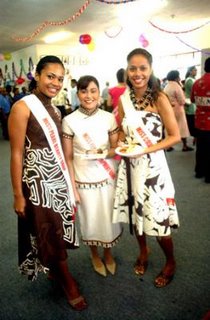On formal occasions, older Fijian women often wear a longish dress and
sulu underskirt but younger women wear a
jiaba and
sulu occasionally - a fitted top with matching
sulu with elastic in the waistline. Of course modern girls wear clothes suitable for different occasions such as sport, dance, work - maybe conservative, and sometimes with lots of glamour, sometimes jeans. For housework or fishing a T-shirt and informal
suluvakatoga might suffice. (colourful length of cloth wrapped around). The dress code for tertiary students at FIT requires conservative dress for students so there is an on-going debate about the rights of young women to dress how they please.
The pic of some of the Hibiscus Festival candidates in Suva is taken from a copy of the magazine Marama.

Pretty girls and very nice dresses - another pic of Hibiscus girls.

W.





3 comments:
Personally, I prefer the pre-European contact dress code. Same thing happened in Hawaii. What's up with excessive clothes the missionaries requrie? It's hot in the tropics.
The second picture I added later - and here I think their costumes are really better than the ankle length dresses.
You like the pre-European contact liku! A bit itchy to wear I would think! But of course there is a plus - no washing to do!
W.
Not to wear myself... cotton t-shirt and shorts for me.
Post a Comment